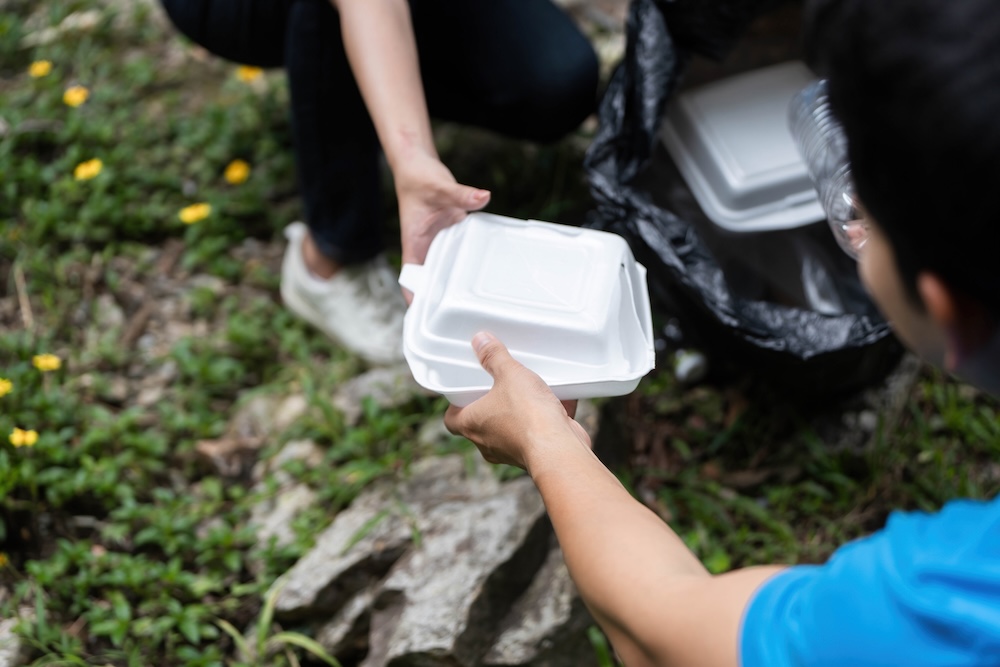Convenience Comes with a Cost—Even After You’re Done Eating
Takeout is easy. It saves time, skips dishes, and fits into busy lives. But once you’ve finished your meal and tossed the container in the trash—or the recycling bin—you probably don’t think about it again.
The thing is, most takeout containers don’t disappear. They don’t break down. And they often don’t get recycled, even when we hope or assume they do.
This post unpacks what really happens after you toss that container—and how your food packaging habits are connected to pollution, landfill overload, and even climate change.
What’s in a Takeout Container?
Takeout containers come in many forms:
- Styrofoam clamshells
- Plastic bowls or trays
- Paper boxes with plastic linings
- Compostable containers made from cornstarch, sugarcane, or PLA
- Aluminum foil containers
- Plastic bags, utensils, and sauce packets
- Napkins, drink cups, straws, and lids
Each of these materials has its own afterlife—and many are more problematic than they appear.
Why Most Takeout Packaging Isn’t Recycled
Even if you place your container in the blue bin, here’s why it often still ends up in the landfill:
1. Food Residue Makes It “Contaminated”
- Pizza grease, sauce, and leftovers make paper unrecyclable
- Plastic with residue gets rejected at sorting facilities
- Mixed-material containers (paper lined with plastic or foil) are rarely recyclable at all
2. Plastic Codes Don’t Guarantee Recyclability
- Many takeout containers are made from #5 (polypropylene) or #6 (polystyrene)—both hard to recycle
- Even recyclable plastics may not be accepted locally or economically viable to process
3. Compostable Doesn’t Mean Backyard Compostable
- Many “eco” containers need industrial composting facilities to break down
- If tossed in the trash, they behave like regular trash
- If tossed in backyard compost, they may never break down at all
Where It All Ends Up
Let’s follow the path of the average takeout container.
In a landfill:
- Paper-based containers decompose without oxygen, releasing methane, a potent greenhouse gas
- Plastic containers can take hundreds of years to break down
- Compostable containers behave like plastic if not processed correctly
- Even aluminum, though infinitely recyclable, often isn’t due to food contamination
In the environment:
- Wind or rain carries light packaging into storm drains, rivers, and oceans
- Wildlife mistake it for food or get entangled in it
- Plastics break down into microplastics, which enter the food chain
In incinerators:
- Burning plastic and coated containers releases dioxins, heavy metals, and CO₂
- Energy recovery doesn’t undo the upstream emissions from producing those materials in the first place
The Upstream Impact: Making It All in the First Place
Every container has a supply chain—from raw material extraction to manufacturing to transportation. That process consumes:
- Fossil fuels for plastic, transportation, and heat
- Trees and water for paper and pulp
- Energy for creating coatings, printing, and sealing
- Chemicals that often go unregulated and untested
The result? A massive environmental footprint for something used for minutes and discarded forever.
Better Ways to Do Takeout Without the Guilt
You don’t have to give up convenience or eating out—but you can do it smarter.
1. Ask for No Utensils or Extras
Skip the napkins, plastic forks, straws, and sauces if you’re eating at home.
If ordering through an app, look for the “no cutlery” option.
2. Bring Your Own Reusables (When Possible)
Some restaurants allow you to bring your own container for pickup orders.
Keep a takeout kit in your car: container, utensils, straw, cloth napkin.
3. Support Restaurants with Sustainable Packaging
Order from places that use truly compostable or recyclable materials
Ask restaurants what kind of packaging they use—feedback drives change
4. Compost or Recycle Correctly
If composting, make sure your city accepts food-soiled paper or bioplastics
Rinse containers before recycling
Avoid tossing mixed-material containers in the blue bin—they often contaminate the whole batch
5. Make Takeout the Exception, Not the Habit
Batch cook meals or freeze leftovers to reduce how often you order
When you do order, try restaurants that use minimalist packaging or give eco-discounts
Common Questions About Takeout Waste
Aren’t paper containers better than plastic?
Sometimes—but not always. If lined with plastic or coated with wax, they aren’t recyclable or compostable. Plain paper is better, but food contamination still matters.
What’s wrong with compostable packaging?
Most compostable containers require industrial composting to fully break down. If sent to landfill or home compost, they often act like plastic.
Doesn’t recycling fix this?
Recycling helps—but most takeout containers are not actually recycled. Contamination and material type are huge barriers.
Should I stop getting takeout?
Not necessarily. Just do it mindfully. Less often. With less waste. From better sources.
Final Thoughts: The Meal Ends, But the Waste Stays
That quick container you tossed at lunch might still be sitting in a landfill in 100 years. Or floating off the coast. Or broken into particles in a fish’s belly.
But this isn’t about shame—it’s about noticing. And choosing better.
Next time you order takeout, ask:
“What will happen to this container when I’m done?”
And if the answer doesn’t sit right—know that you have better options. And they start with awareness.









Reader Interactions